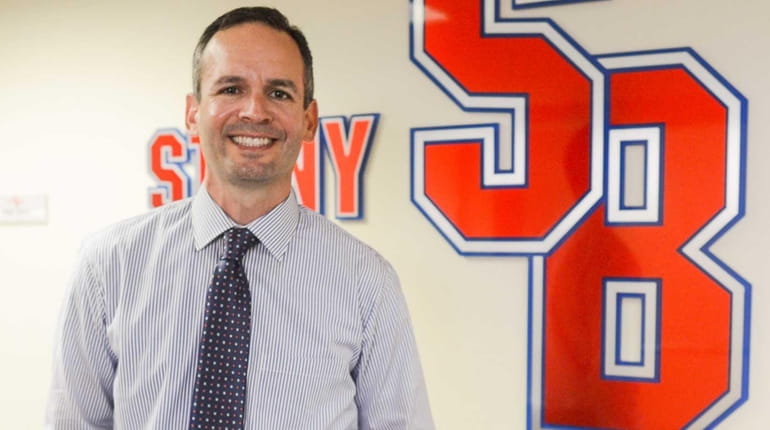Stony Brook athletic director Shawn Heilbron's goal: Raising $100 million

Stony Brook University Athletic Director Shawn Heilbron poses in his office while showing off new plans for the athletic department on on Aug. 26, 2015. Credit: Andrew Theodorakis
From the moment he first set foot on Stony Brook's campus to take over as athletic director in May 2014, Shawn Heilbron said his vision was to build a football program powerful enough to drive the fundraising necessary to put the New York state school with the funny name on the major-college athletic map.
Exactly one year later, Heilbron unveiled his five-year program titled "Together We Transform" to accomplish that goal. It came with a variety of new initiatives intended to build a big-time college football culture on Long Island that might begin to generate the revenue necessary to turn the artist's renderings of a double-decked stadium seating 25,000 and an indoor practice facility into actual brick and mortar.
The price tag for everything in the five-year package? Take a deep breath.
"The number we use internally is we need to raise $100 million," Heilbron told Newsday. "It's a lot of money. That can come from the state, it can come from private donors, but that's the reality.
"It's not just facilities. It's operating dollars; it's hiring staff; it's everything we have in that plan. That's our goal over the next five years. It's a big number, but I'm excited about the challenge. I know what Stony Brook University has done to attract new donors, and it gives me hope we'll be able to get there."
FORWARD PROGRESS
Stony Brook football attracted a record homecoming crowd of 11,301 last season, but the average attendance for six home games at 8,136-seat Kenneth P. LaValle Stadium was 7,105 at a school at which fan interest and especially student attendance tends to tail off when the weather turns cold. So it challenges the imagination to envision a 25,000-seat stadium filled to capacity for a Seawolves team that has moved up from the Football Championship Subdivision (FCS) to the Football Bowl Subdivision (FBS) to play with the big boys in the future.
With a laugh, football coach Chuck Priore said, "Hopefully, I won't be six feet under."
Turning serious, he said strides taken by the athletic program in his nearly 10 years on the job are an indication of what can be achieved. "We've seen the movement of this program," he said. "I took over Jan. 1, 2006, without having any scholarships.
"A lot of people's hard work went into this in my tenure and before. The stadium wouldn't be here if Shirley [former SBU president Shirley Strum Kenny] didn't have a vision. It's exciting. Stony Brook is successful as a university because they have a vision, and I think we're parlaying that into athletics to help the school as they help us."
Under Priore, Stony Brook has moved from the Northeast Conference to the Big South to the Colonial Athletic Association and progressively tougher opposition at the FCS level, formerly known as Division I-AA. All of SBU's other athletic teams compete in the America East, which doesn't have football.
Heilbron said the current two conference affiliations have served Stony Brook well, but he added, "My job is to position our department for uncertainty and for future growth. Any move we would make has to be right for us. It has to be a situation where we can win, because this is about long-term growth for the athletic department. I see ourselves years down the road competing with what one would consider big-name schools and conferences."
All 10 FBS conferences -- the "Power Five" (ACC, Big Ten, Big 12, Pac-12 and SEC) and the "Group of Five" (American, Conference USA, MAC, Mountain West and Sun Belt) -- have gone through a turbulent period of realignment during the past four years. The landscape is calm now, but Heilbron predicted that the Big 12, which was reduced to 10 schools, might look to expand and start the dominoes falling again.
Looking at the Group of Five conferences, which now are spread all over the map, Heilbron suggested that travel costs and class time missed by student-athletes could spur a reassessment that leads to changes that make more financial sense. If and when that happens, Heilbron wants Stony Brook to be ready to take a step up, as former CAA member Old Dominion did two years ago when it joined Conference USA.
"I at least want to be in the position to be seen as a good candidate," Heilbron said. "I believe we are because of our market, because of our academic standing and because of what we're going to invest in to get to that point where we're winning on a regular basis.
"You're looking at going from 63 to 85 scholarships. There's a major cost associated with it. But there's tremendous opportunity that comes with it also. There is a lot of money that needs to be raised and infrastructure that has to be put in place to not just sustain but to win at that level."
MR. FUNDRAISER
Heilbron was hired by current SBU president Samuel L. Stanley because of his successful fundraising ability at previous jobs with SMU, UCLA and, most recently, Oregon State. As part of his five-year plan, Heilbron began a donor group known as "Seawolves United." The modest goal now is to reach at least $1 million per year in unrestricted gifts and go from there.
At the moment, Stony Brook's annual athletic department budget is approximately $28 million, and Heilbron hopes to grow that incrementally. The University of Oregon, which receives significant help from Nike and chairman Phil Knight, currently has the highest budget in the country at $196 million, according to a USA Today survey, but Heilbron said many FBS schools have operated successfully on $50 million annually.
Heilbron said SBU has state money available to fund a 2,000-seat expansion in the unoccupied north end zone that will push LaValle Stadium's capacity past 10,000. But for the most part, it will take private donations to fund improvement, starting with an indoor practice facility that will be used not only by the football team but several other sports.
The projected cost of that facility is at least $10 million. In May, Heilbron met in New York City and Port Jefferson with prospective donor groups and told them, "This indoor facility is something we have to have right now. At this point next year, we should be digging in the ground or getting ready to."
Heilbron told Newsday the school has received a "lead gift" for the indoor practice facility that it expects to announce in the near future, but more fundraising is necessary to meet the total cost of the project.
Then the focus will turn to major stadium expansion. "We have designs for the larger expansion of the football stadium, which we absolutely need to do over a period of time," Heilbron said. "We know that will require significant investment and also a football operations building."
Additionally, Heilbron said plans call for improvements at Joe Nathan Field for baseball, the softball stadium and locker- room facilities for all sports; issues must be addressed for tennis, soccer and track, and expanding or replacing the academic center is a consideration.
When he met with potential donors in May, Heilbron explained the need for a much bigger football plant this way: "I'm from Texas, a state that lives, breathes and dies for football. We have to develop that culture here. We've got a great stadium, but in Texas, that's a nice high school stadium.
"That's not a knock. That's the reality. What do we do to change this perception? Football on Long Island and in New York is not what it is in other states."
IF YOU BUILD IT . . .
Changing that culture is the most difficult challenge Heilbron faces. The New York metropolitan area is saturated with multiple professional teams in the NFL, NBA, MLB, NHL and MLS.
"I think there's a place for college sports in any market," Heilbron said. "I'm from Dallas, and it's dominated by the Cowboys. When I was at SMU, we used to beat our heads against the wall trying to figure that out. But if you give people a reason to come, there's nothing greater than college game day."
The notion of generating enough interest in Stony Brook football to eventually fill a 25,000-seat stadium may seem like a pipe dream, but Heilbron is looking at a different set of numbers. "When I think about the fact there are 1.5 million people in Suffolk County, and all we need to do now is get 10,000 to come out for six Saturdays, I know we can do it," he said. "If we look at what it will take to draw 20,000, I know it's possible.
"The day will come when Stony Brook has a 25,000-seat stadium and is filling it on a regular basis. Whether that happens in five years, I don't know, but that's certainly what we're going to work toward."
The plan calls for a variety of initiatives to help more fans connect with Stony Brook football. An area outside the stadium dubbed "Seawolves Town" will facilitate tailgating. The student section has been moved from the south end zone to the west side stands behind the visitors' bench in the hope that cheering will resonate across the field to the press-box side. Names also have been added to the back of players' jerseys for easy identification.
A key part of the marketing strategy is a new radio partnership with Connoisseur Media, which will broadcast all home and away football games on 94.3 FM. "Ultimately, it comes down to winning," Heilbron said. "If there's one thing I know about New York, they love winners. We're going to deliver that."
At one of the May meetings with potential donors, Priore joked that the increased emphasis on football comes with additional pressure. But he lauded his players, staff and a supportive administration for working to make it happen.
"This year, we were fully funded for everything," Priore said.
In the past, players left school in mid-May and returned at the start of August for training camp. But this year, the football program received the financial support needed to keep the whole team on campus working out during the first summer session, and injured players remained through the second summer session while rehabbing.
Priore was part of the faculty committee that interviewed Heilbron for the job. He liked what he saw then, and his judgment has been reinforced during the past year they have worked together.
"The thing I live by in the business world is when people tell me someone is 'regular people,' " Priore said. "That was the comment I got back from people who knew Shawn, and that's what I've seen. His ego is in his pocket, and he knows it's important to build relationships and do things the right way. He's given me and our players nothing but support in a positive way."
Heilbron described Priore as the right fit for the program, saying, "He bleeds Stony Brook." And the athletic director said the pressure really is on his administration to give all the coaches the tools needed to succeed.
But when all is said and done, the $100-million price tag Heilbron put on his vision for Stony Brook athletics is a whopping big number, and there is only one way to reach it.
"If we're perennially unsuccessful, it won't matter," Heilbron said. "We won't be a strong candidate [for FBS expansion] and we won't generate the donations and the fan support. So we have to be successful. There's no other option."

